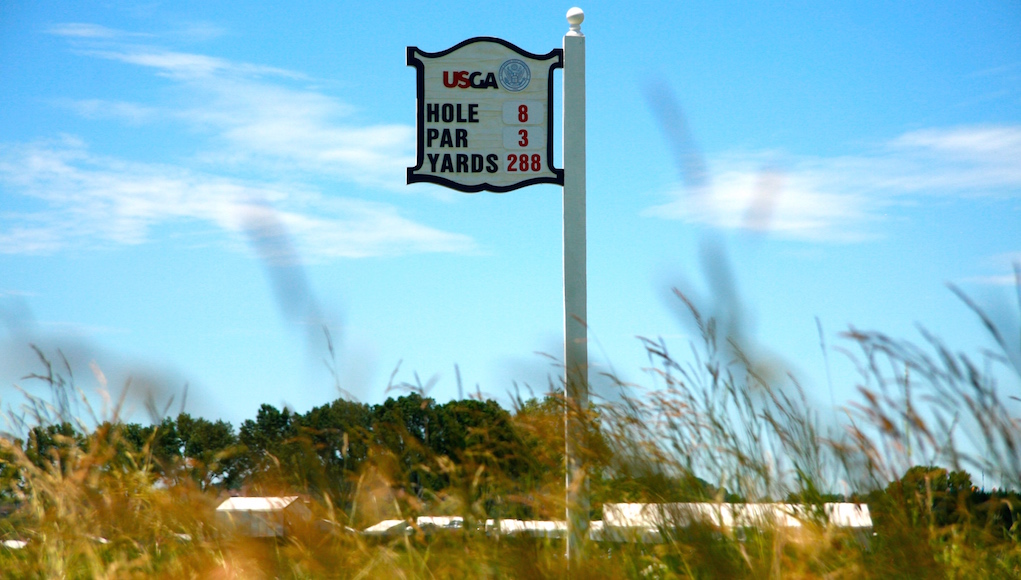Opinion & Analysis
What’s so difficult about Oakmont, anyway?

It’s a golf tradition unlike any other; players complaining about the U.S. Open setup ahead of the event. The course is either too long, too dried out, the rough too long, the greens too fast, or some combination of all those factors. And golf fans relish in hearing the complaints. It’s one of the few times each year when the best players in the world make fools of themselves when competing against par.
There’s something different about how players talk about this year’s U.S. Open at Oakmont Country Club, though. When they talk about the setup, or how how difficult the course is, there’s legitimate fear in their eyes. Every year the media, course members and players predict an over-par winning score, but at Oakmont you can sense that everyone is serious about it.
What makes Oakmont so difficult? I traveled there to find out, and asked the fans what they believe makes the course so treacherous.
What bunkers?
“The biggest problem is that you can’t even see some of these bunkers they’re so deep,” one fan said.
While U.S. Open contestants will know where all the bunkers are located, they won’t be able to see many of them from the tee or from the fairway. And the bunkers they can’t see are some of the deepest, most penalizing bunkers on the course.
“I’d be stuck in some of these bunkers and would never get out,” a fan said.
- Church Pews, hole No. 3
- The mounds in the Church Pew bunker are taller than they appear on video.
- Church Pew bunker, hole No. 15
- A bunker guarding the green at hole No.6, with a lip nearly taller than this player.
And when you do see the bunkers, like the Church Pews on the left of Nos. 3 and 4, or the Church Pews on the left of No. 15 — actually most, of the 200-plus bunkers on the course — you wish you hadn’t.
The green complexes are… complex
On No. 2 green, I watched players, caddies, coaches and whoever else was in the practice-round entourage gather at the center of that green, rolling and dropping golf balls to see how they would react. On multiple occasions, I watched someone drop a golf ball in the center of the green only to watch it slowly funnel off of the green down into the fairway.
“One second you’re putting, and then all the sudden you’re chipping,” one fan told me. “For me, I’d be putting, putting and then chipping,” his friend responded.
The green complexes are firm, diabolical, and just purely fast. They’re rumored to be running at a 14 on the Stimpmeter. That’s unheard of for any golf course that isn’t named Augusta, which doesn’t release its green speeds.
To give fans an experience of the greens at Oakmont, the USGA set up an exact replica of the 18th green for fans to test out their strokes. Oakmont caddies were stationed at the greens to help out.
“It’s like putting on a sloped basketball court,” one fan told me.
Maybe Rory McIlroy wasn’t kidding when he said he’d rather have a 30-footer uphill than an 8-footer downhill.
Where art thou iron byron?
“I could bring a portable Iron Byron out here and not hit every fairway,” a fan told me.
Oakmont is long, a par-70 that will play around 7,200 yards depending on the tees, but it’s not THAT long compared to some of the other U.S. Open venues, or even regular Tour stops. It’s how tight some of the landing areas are that makes it play longer. It’s a must that players keep their ball in the fairway due to long rough and deep bunkers. That’s why you’ll hear many of them saying they’ll only use driver off the tee 4-8 times each round, opting for more control with long irons, fairway woods woods and hybrids off the tees.
“It’s one of those courses where if you drink a few too many beers, you could be walking in the fairway, stumble just a little, and end up in the rough. The fairways are just stupid tight,” said one fan.
He may have already had a few beers that day, as well.
The blind leading the blind
“I didn’t realize how much elevation change was at this place,” a fan said. “You can hardly see anything on some holes.”
Like the bunkers, it’s difficult to see many of the landing areas from the tees at Oakmont, especially on Nos. 1, 5, 9, 15 and 17. That means players must put their ultimate trust in their preparation and the target lines they’ve established prior to the event.
The Hardest Hole
I got a different answer to the question “What do you think is the hardest hole out here?” from nearly everyone I asked, but the most common answers were holes 1, 2, 7, 8 and 18.
No. 1 (Par 4, 482 yards)
Why not? A 118-yard putt on the first hole at #Oakmont. pic.twitter.com/GRU0E29Zvu
— Guy Cipriano (@GCIMagazineGuy) April 25, 2016
This video says it all.
No. 2 (Par 4, 340 yards)
See above: One second you’re rolling balls onto the green, the next, you’re following the balls as they roll off the green.
No. 7 (Par 4, 479 yards)
“That hole seems too unfair from all the way back where they need to play from,” said a fan, shaking his head.
I’m sure some of the players agree, especially when you consider how the green slopes hard from left-to-right.
No. 8 (Par 3, 288/250 yards)
“I’d probably hit driver-6 iron here, and then have a short chip on.”
This 288-yard par 3, or 250 yards, depending what tee box the USGA uses that round, is cause of terror for most fans who collect on that tee box. But the truth is, most of the players hit hybrids and long irons. Angel Cabrera hit a 6-iron (gasp) during Monday’s practice round.
“The ball gets a nice ground hook once it lands in front of the green, so you only have to carry it about 250,” one caddie said.
A 250-yard 6-iron is still a big hit, regardless.
No. 18 (Par 4, 484 yards)
It may be the most difficult finishing hole in golf. In 2007, only 43 percent of the players hit the green in regulation, and it was statistically the most difficult hole on the course in relation to par.
“I’m not sure whether the hole itself is that hard, or it’s just because you’ve been beaten to shreds on the previous 17,” a fan hypothesized.
Probably a bit of both.
The rough is longer than…
There’s been plenty of talk, visuals and Twitter videos from players and media about how long the rough is at Oakmont. But none more hilarious than this interaction between a couple in their mid-twenties.
“This rough is longer than my…” said the man.
“Yea, a lot longer,” says the woman.
Ouch.
So what makes Oakmont so difficult? It’s the combination of not just one thing, or a few of these things, but ALL of these factors. Oakmont might very well be the most difficult test of golf in the U.S., and we may very well see a winning score in the black.
When asked if he would cherish the opportunity to play a course like this, a 4-handicap golfer answered “Ain’t nothin’ fun about not breaking 90.” We may just see a U.S. Open participant fail to break 90 this week, as well.
Thanks to all of the fans who put up with my questions during the practice rounds!
Opinion & Analysis
The 2 primary challenges golf equipment companies face

As the editor-in-chief of this website and an observer of the GolfWRX forums and other online golf equipment discourse for over a decade, I’m pretty well attuned to the grunts and grumbles of a significant portion of the golf equipment purchasing spectrum. And before you accuse me of lording above all in some digital ivory tower, I’d like to offer that I worked at golf courses (public and private) for years prior to picking up my pen, so I’m well-versed in the non-degenerate golf equipment consumers out there. I touched (green)grass (retail)!
Complaints about the ills of and related to the OEMs usually follow some version of: Product cycles are too short for real innovation, tour equipment isn’t the same as retail (which is largely not true, by the way), too much is invested in marketing and not enough in R&D, top staffer X hasn’t even put the new driver in play, so it’s obviously not superior to the previous generation, prices are too high, and on and on.
Without digging into the merits of any of these claims, which I believe are mostly red herrings, I’d like to bring into view of our rangefinder what I believe to be the two primary difficulties golf equipment companies face.
One: As Terry Koehler, back when he was the CEO of Ben Hogan, told me at the time of the Ft Worth irons launch, if you can’t regularly hit the golf ball in a coin-sized area in the middle of the face, there’s not a ton that iron technology can do for you. Now, this is less true now with respect to irons than when he said it, and is less and less true by degrees as the clubs get larger (utilities, fairways, hybrids, drivers), but there remains a great deal of golf equipment truth in that statement. Think about it — which is to say, in TL;DR fashion, get lessons from a qualified instructor who will teach you about the fundamentals of repeatable impact and how the golf swing works, not just offer band-aid fixes. If you can’t repeatably deliver the golf club to the golf ball in something resembling the manner it was designed for, how can you expect to be getting the most out of the club — put another way, the maximum value from your investment?
Similarly, game improvement equipment can only improve your game if you game it. In other words, get fit for the clubs you ought to be playing rather than filling the bag with the ones you wish you could hit or used to be able to hit. Of course, don’t do this if you don’t care about performance and just want to hit a forged blade while playing off an 18 handicap. That’s absolutely fine. There were plenty of members in clubs back in the day playing Hogan Apex or Mizuno MP-32 irons who had no business doing so from a ballstriking standpoint, but they enjoyed their look, feel, and complementary qualities to their Gatsby hats and cashmere sweaters. Do what brings you a measure of joy in this maddening game.
Now, the second issue. This is not a plea for non-conforming equipment; rather, it is a statement of fact. USGA/R&A limits on every facet of golf equipment are detrimental to golf equipment manufacturers. Sure, you know this, but do you think about it as it applies to almost every element of equipment? A 500cc driver would be inherently more forgiving than a 460cc, as one with a COR measurement in excess of 0.83. 50-inch shafts. Box grooves. And on and on.
Would fewer regulations be objectively bad for the game? Would this erode its soul? Fortunately, that’s beside the point of this exercise, which is merely to point out the facts. The fact, in this case, is that equipment restrictions and regulations are the slaughterbench of an abundance of innovation in the golf equipment space. Is this for the best? Well, now I’ve asked the question twice and might as well give a partial response, I guess my answer to that would be, “It depends on what type of golf you’re playing and who you’re playing it with.”
For my part, I don’t mind embarrassing myself with vintage blades and persimmons chasing after the quasi-spiritual elevation of a well-struck shot, but that’s just me. Plenty of folks don’t give a damn if their grooves are conforming. Plenty of folks think the folks in Liberty Corner ought to add a prison to the museum for such offences. And those are just a few of the considerations for the amateur game — which doesn’t get inside the gallery ropes of the pro game…
Different strokes in the game of golf, in my humble opinion.
Anyway, I believe equipment company engineers are genuinely trying to build better equipment year over year. The marketing departments are trying to find ways to make this equipment appeal to the broadest segment of the golf market possible. All of this against (1) the backdrop of — at least for now — firm product cycles. And golfers who, with their ~15 average handicap (men), for the most part, are not striping the golf ball like Tiger in his prime and seem to have less and less time year over year to practice and improve. (2) Regulations that massively restrict what they’re able to do…
That’s the landscape as I see it and the real headwinds for golf equipment companies. No doubt, there’s more I haven’t considered, but I think the previous is a better — and better faith — point of departure when formulating any serious commentary on the golf equipment world than some of the more cynical and conspiratorial takes I hear.
Agree? Disagree? Think I’m worthy of an Adam Hadwin-esque security guard tackle? Let me know in the comments.
@golfoncbs The infamous Adam Hadwin tackle ? #golf #fyp #canada #pgatour #adamhadwin ? Ghibli-style nostalgic waltz – MaSssuguMusic
Podcasts
Fore Love of Golf: Introducing a new club concept

Episode #16 brings us Cliff McKinney. Cliff is the founder of Old Charlie Golf Club, a new club, and concept, to be built in the Florida panhandle. The model is quite interesting and aims to make great, private golf more affordable. We hope you enjoy the show!
Opinion & Analysis
On Scottie Scheffler wondering ‘What’s the point of winning?’

Last week, I came across a reel from BBC Sport on Instagram featuring Scottie Scheffler speaking to the media ahead of The Open at Royal Portrush. In it, he shared that he often wonders what the point is of wanting to win tournaments so badly — especially when he knows, deep down, that it doesn’t lead to a truly fulfilling life.
View this post on Instagram
“Is it great to be able to win tournaments and to accomplish the things I have in the game of golf? Yeah, it brings tears to my eyes just to think about it because I’ve literally worked my entire life to be good at this sport,” Scheffler said. “To have that kind of sense of accomplishment, I think, is a pretty cool feeling. To get to live out your dreams is very special, but at the end of the day, I’m not out here to inspire the next generation of golfers. I’m not out here to inspire someone to be the best player in the world, because what’s the point?”
Ironically — or perhaps perfectly — he went on to win the claret jug.
That question — what’s the point of winning? — cuts straight to the heart of the human journey.
As someone who’s spent over two decades in the trenches of professional golf, and in deep study of the mental, emotional, and spiritual dimensions of the game, I see Scottie’s inner conflict as a sign of soul evolution in motion.
I came to golf late. I wasn’t a junior standout or college All-American. At 27, I left a steady corporate job to see if I could be on the PGA Tour starting as a 14-handicap, average-length hitter. Over the years, my journey has been defined less by trophies and more by the relentless effort to navigate the deeply inequitable and gated system of professional golf — an effort that ultimately turned inward and helped me evolve as both a golfer and a person.
One perspective that helped me make sense of this inner dissonance around competition and our culture’s tendency to overvalue winning is the idea of soul evolution.
The University of Virginia’s Division of Perceptual Studies has done extensive research on reincarnation, and Netflix’s Surviving Death (Episode 6) explores the topic, too. Whether you take it literally or metaphorically, the idea that we’re on a long arc of growth — from beginner to sage elder — offers a profound perspective.
If you accept the premise literally, then terms like “young soul” and “old soul” start to hold meaning. However, even if we set the word “soul” aside, it’s easy to see that different levels of life experience produce different worldviews.
Newer souls — or people in earlier stages of their development — may be curious and kind but still lack discernment or depth. There is a naivety, and they don’t yet question as deeply, tending to see things in black and white, partly because certainty feels safer than confronting the unknown.
As we gain more experience, we begin to experiment. We test limits. We chase extreme external goals — sometimes at the expense of health, relationships, or inner peace — still operating from hunger, ambition, and the fragility of the ego.
It’s a necessary stage, but often a turbulent and unfulfilling one.
David Duval fell off the map after reaching World No. 1. Bubba Watson had his own “Is this it?” moment with his caddie, Ted Scott, after winning the Masters.
In Aaron Rodgers: Enigma, reflecting on his 2011 Super Bowl win, Rodgers said:
“Now I’ve accomplished the only thing that I really, really wanted to do in my life. Now what? I was like, ‘Did I aim at the wrong thing? Did I spend too much time thinking about stuff that ultimately doesn’t give you true happiness?’”
Jim Carrey once said, “I think everybody should get rich and famous and do everything they ever dreamed of so they can see that it’s not the answer.”
Eventually, though, something shifts.
We begin to see in shades of gray. Winning, dominating, accumulating—these pursuits lose their shine. The rewards feel more fleeting. Living in a constant state of fight-or-flight makes us feel alive, yes, but not happy and joyful.
Compassion begins to replace ambition. Love, presence, and gratitude become more fulfilling than status, profits, or trophies. We crave balance over burnout. Collaboration over competition. Meaning over metrics.
Interestingly, if we zoom out, we can apply this same model to nations and cultures. Countries, like people, have a collective “soul stage” made up of the individuals within them.
Take the United States, for example. I’d place it as a mid-level soul: highly competitive and deeply driven, but still learning emotional maturity. Still uncomfortable with nuance. Still believing that more is always better. Despite its global wins, the U.S. currently ranks just 23rd in happiness (as of 2025). You might liken it to a gifted teenager—bold, eager, and ambitious, but angsty and still figuring out how to live well and in balance. As much as a parent wants to protect their child, sometimes the child has to make their own mistakes to truly grow.
So when Scottie Scheffler wonders what the point of winning is, I don’t see someone losing strength.
I see someone evolving.
He’s beginning to look beyond the leaderboard. Beyond metrics of success that carry a lower vibration. And yet, in a poetic twist, Scheffler did go on to win The Open. But that only reinforces the point: even at the pinnacle, the question remains. And if more of us in the golf and sports world — and in U.S. culture at large — started asking similar questions, we might discover that the more meaningful trophy isn’t about accumulating or beating others at all costs.
It’s about awakening and evolving to something more than winning could ever promise.




























Dave
Jun 19, 2016 at 10:34 pm
love the comments . But like logical said its getting old
PuffyC
Jun 19, 2016 at 3:50 pm
At some point you cross from difficult to silly, where dumb luck starts to play a factor in who wins and loses. I’d rather see a course that rewards true skill, not luck on blind tee shots, bad kicks into knee length rough, or a ball that happens to stick on the green instead of rolling back into the fairway. It’s not fun to watch and I assume not fun to play.
Tom
Jun 19, 2016 at 9:07 am
Although its turf conditions are second to none (no doubt about that), the course barely squeaks into the top 5 in Western PA alone.That “return the golf course to its original splendor” line that the USGA uses is total crap. Oakmont’s logo is a squirrel!!!!!!!! I love the US Open but the USGA has become the emperor with no clothes. Yesterday, I heard an announcer describing all the blind shots at Oakmont like it was a good thing. And it wasn’t even Jim Nance.
Hole11
Jun 17, 2016 at 9:21 am
How about fairways 10 yards wide and 12 inch rough. Oh boy would that be tough. No…it would just be stupid. Or greens so fast and sloped no ball would stay on so you’d have to chip it in to finish the hole. Bunkers so deep only an unplayable lay could get you out. Approaching silliness is not impressive, it’s just plain dumb.
.
Other Paul
Jun 16, 2016 at 9:12 pm
i would want to play twice. Once to get adjusted, a night to relax and then another try at it. I have some length, and that makes me brave. Or sometimes stupid…
michael johnson
Jun 16, 2016 at 6:04 pm
i shot an easy 62 the other day at oakmont, so yeah, its really not that difficult.
ooffa
Jun 16, 2016 at 2:01 pm
They all play the same course. Low score wins. Whoever is putting the best this week will win just like every other week on tour. Easy or hard makes no difference. It’s just just another week and another golf course to the pros.
Logical
Jun 16, 2016 at 1:31 pm
This is a silly article. There’s no difference in how they are talking about the course this year, there’s no “fear in their eyes”. There have been many tough setups at US Opens, this isn’t any more or less “special”.
Come on, stop trying to hype the heck out of the course. It’s getting old.